1 - 120 of 319 records
Joan of Arc saved France
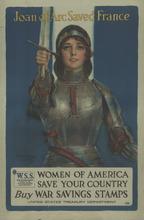
Description: "This World War I poster, issued by the United States Department of the Treasury, urges women to buy war savings stamps to help finance the war effort. The War Savings Stamps (W.S.S.) program aimed to instill patriotism in citizens as well as raise funds. Stamps were available in 10-cent and 25-cent versions, and were bought by school-age children and other small savers. This poster invokes the figure of Joan of Arc (circa 1412–31), the traditionally recognized patriot and martyr of France who led the fight against the English in the Hundred Years' War. The illustration of a beautiful young Joan, raising her sword, is by Haskell Coffin (1878–1941), an American artist best known for his portrayals of women on the covers of The Saturday Evening Post, McCall's Magazine, The American Magazine, Redbook, and other weekly and monthly magazines"--World Digital Library.
Member of: World War I Posters (Collection)
Resource Type: Still Image
U.S. Marines
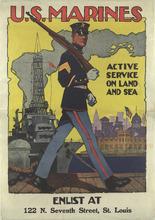
Description: MU: Rest of poster reads: Enlist at 122 N. Seventh Street, St. Louis mounted on canvas.,Poster showing Marine in dress blues marching in front of ship.
Member of: World War I Posters (Collection)
Resource Type: Still Image
Department of Transportation
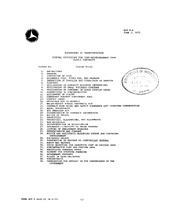
Description: "DOT P-4, June 2, 1972 ; FORM DOT F 4220.20 (6-2-72).",Scanned with Zeutschel OS 15000 scanner using Omniscan scanning software at 600 dpi, grayscale. Images saved as tiff files with LZW compression. Images were cropped, resized, and brightened.
Member of: Works Projects Administration Historical Records Survey
Resource Type: Text
For active service, join the U.S. Marines
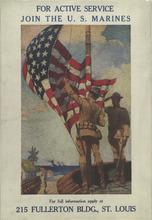
Description: For full information apply at 215 Fullerton Bldg., St. Louis.,MU: Poster mounted on canvas (010-509224830),Poster showing two Marines raising flag with battleships and formation of Marines in background.
Member of: World War I Posters (Collection)
Resource Type: Still Image
Transition Assistance Program
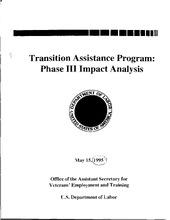
Member of: Works Projects Administration Historical Records Survey
Resource Type: Text
A Stitch in time: 4th Liberty Loan
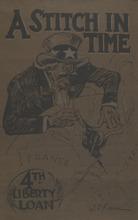
Description: Poster showing Uncle Sam stitching countries of Europe together.
Resource Type: Still Image
Avenge December 7
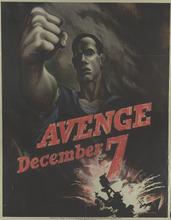
Description: Poster showing, in a somber graphic design, a sailor clenching his fist looming above the image of a sinking naval ship.
Member of: World War I Posters (Collection)
Resource Type: Still Image
Free war exhibit
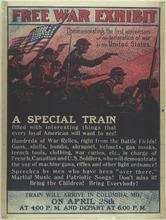
Description: Poster showing soldiers shooting at unseen enemy.,Rest of text reads: A special train filled with interesting things that every loyal American will want to see! Hundreds of war relics, right from the battle fields! Guns, shells, bombs, shrapnel, helmets, gas masks, trench tools ... Speeches by men who have been over there. Martial music and patriotic songs! Don't miss it! Bring the children! Bring everybody! Train will arrive in Columbia, Mo. on April 28th at 4:00 p.m. and depart at 6:00 p.m.
Member of: World War I Posters (Collection)
Resource Type: Still Image
Official notice
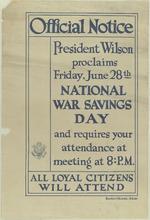
Description: Text only poster printed in blue ink with image of the Great Seal of the United States at left.
Resource Type: Still Image
U. S. Marines, the soldiers of the sea
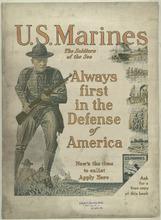
Description: Poster showing Marines fighting on the left and various scenes of Marine activities on the right.,Right bottom corner reads: Ask for a free copy of this book.,MU: Poster stamped at bottom: U. S. Marine Recruiting Station, 306 College Street, Springfield, Mo.,MU: Poster mounted on canvas.
Member of: World War I Posters (Collection)
Resource Type: Still Image
Family enrollment week, Oct. 28th to Nov. 4th
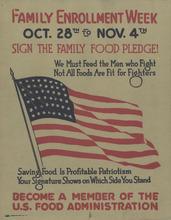
Description: Poster showing American flag in center asking people to sign the family food pledge.
Resource Type: Still Image
Veterans of the big war
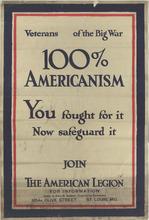
Description: Text in blue with red and blue borders.,Join the American Legion.,MU: Poster mounted on canvas.,MU: University of Missouri Library stamp, Oct 30 1947 on verso.,For more information, apply to John S. Seibert, Organizing Secretary, 1214a Olive Street, St. Louis, MO.
Member of: World War I Posters (Collection)
Resource Type: Still Image
Veterans of the big war, we have stood together, let's stick together
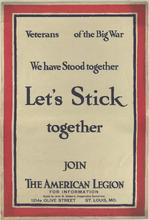
Description: For information apply to John S. Seibert, organizing secretary, 1214a Olive Street, St. Louis, Mo.,MU: Poster mounted on canvas.
Member of: World War I Posters (Collection)
Resource Type: Still Image
Boys and girls!
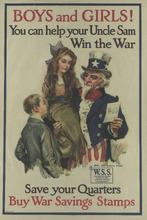
Description: Poster showing Uncle Sam with a girl and boy.
Resource Type: Still Image
Lest we perish
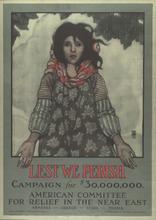
Description: Poster showing Near Eastern girl with arms outstretched.
Member of: World War I Posters (Collection)
Resource Type: Still Image
Exhibit of American Federation of Labor
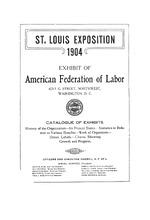
Description: Catalogue of exhibits -- History of the organization -- Its present status -- Statistics in relation to various benefits -- Work of organizers -- Union labels -- Charts showing growth and progress.,Title from NUC pre-1956 imprints.,At head of title: St. Louis Exposition, 1904.
Member of: Louisiana Purchase Exposition: The 1904 St. Louis World's Fair (Collection)
Resource Type: Text
Second patriotic food show.
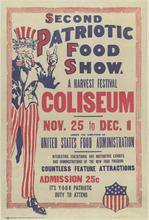
Description: Poster in red, white and blue showing Uncle Sam standing on left pointing to text.
Resource Type: Still Image
Colored map of Louisiana Purchase territory and all acquisitions
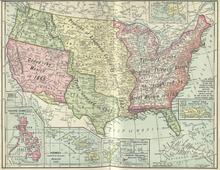
Description: Shows the territory of the original 13 states and United States land acquisitions and annexations including Louisiana Purchase, Florida, Alaska, Texas, Hawaii, the southwestern United States, the Gadsden Purchase, the establishment of the settlement line with Great Britain of the Oregon Territory, and other islands.
Member of: Miscellaneous Maps (Collection)
Resource Type: cartographic
Map of the United States, constructed from the latest authorities, 1826
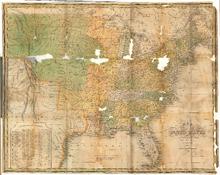
Description: Folded in leather cover.,Scale: ca. 1:730,000.,"The publisher is indebted to the politeness of Major S. H. Long for the use of his documents in the construction of that portion of this map west of the Mississippi River.","J. H. Young S..." (Border damaged; balance of word wanting),Map drawn by David H. Vance.
Member of: Miscellaneous Maps (Collection)
Resource Type: cartographic
America : Being the latest, and most accurate description of the New World : [pages 277-278]

Description: Leaf (pages 277-278) from an early travel book on the Americas originally published by John Ogilby, 1671. Parts of text based on Arnoldus Montanus's "De Nieuwe en onbekende weereld: of beschryving van America en't zuid-land." Engraving top of page 277 illustrates a description of the "Inhabitants of Mexico." "…Cloth'd in Cotton: On their heads they wore a high Plume of red Feathers; about their Necks, over their Shoulders, Breast and Back, a kind of large Thorax of Feathers curiously pleited ; each Arm adorn'd with Armlets, and their Middles girt with broad white Girdles full of red Streaks ; in stead of Garters they wore Laces of Feathers, as also a little above their Ancles."
Member of: Pages from the past - all pages
Resource Type: Text
Moral reflection
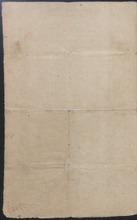
Description: Original manuscript : 31 x 19 cm,Original was inserted in back of Lucubrator.,Holograph.
Member of: Lucubrator (Collection)
Resource Type: Text
Domestic slavery considered as a Scriptural institution
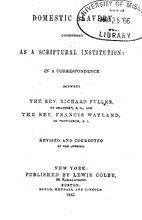
Member of: All Books and Texts
Resource Type: Text
The Territorial papers of the United States, Volume 15. The territory of Louisiana-Missouri, 1815-1821. The Territory of Louisiana-Missouri, 1803-1821,Territory of Louisiana-Missouri, 1802-1821

Description: [v. 1]. 1803-1806 -- [v. 2]. 1806-1814 -- [v. 3] 1815-1821.,Issued by the Dept. of State as its Publication no. 3096, 3502; National Archives Publication 51-9.,Includes bibliographical references and indexes.
Member of: Territorial papers of the United States (Multi-volume set)
Resource Type: Text
The Territorial papers of the United States, Volume 14. The territory of Louisiana-Missouri, 1806-1814,Territory of Louisiana-Missouri, 1802-1821
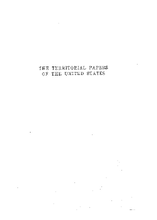
Description: Issued by the Dept. of State as its Publication no. 3096, 3502; National Archives Publication 51-9.,Includes bibliographical references and indexes.,LSO ID: umlc000005.
Member of: Territorial papers of the United States (Multi-volume set)
Resource Type: Text
Boone Stop
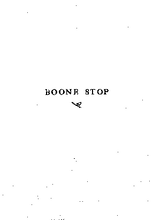
Description: LSO ID: umlc000038.
Member of: Missouriana: All Volumes (Collection)
Resource Type: Text
Contemporary American conception of equality among men as a social and political ideal

Description: At head of title: University of Missouri, Phi beta kappa.
Member of: All Books and Texts
Resource Type: Text
A Full description of the soil, water, timber, and prairies of each lot, or quarter section of the military lands between the Mississippi and Illinois rivers
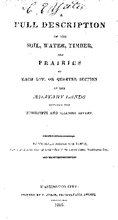
Description: LSO ID: umlk000015.
Member of: Missouriana: Geology (Collection)
Resource Type: Text
JM-192: Nope!
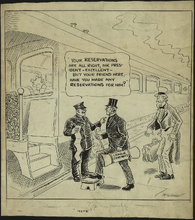
Description: This cartoon shows President Woodrow Wilson boarding a train. Uncle Sam is attempting to also board the train, but it seems he does not have a reservation. The bag President Wilson is carrying is titled, "League Covenant". This bag most likely refers to President Wilson's ambition to form the League of Nations, an collection of nations working together to create international unity. The League of Nations existed from 1920 to 1946. The United States never officially joined the League of Nations, because congress feared its membership would limit the United States' national sovereignty. At the time, many Americans suggested joining the League of Nations would not benefit the United States. However, there was also a population of Americans, including Woodrow Wilson, who believed The League of Nations' efforts towards international peace would offer great benefits to the United States. (Summary created by Mary Delano, MU History Intern, Spring 2018)
Member of: McCutcheon Editorial Cartoons - ALL (Collection)
Resource Type: Still Image
JM-179: There are some Congressmen who don't want the Germans to see we are in earnest
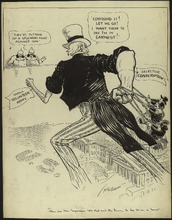
Description: This cartoon depicts Uncle Sam being held back by by men from fighting with his full strength. Uncle Sam is meant to personify the United States. Uncles Sam's weak arm represents the feeble military forces available through voluntary enlistment. Uncle Sam's bulky arm represents the United States's powerful military capability if it enacted the draft. The group holding back Uncle Sam is representative of congress. The two Germans represent Germany across the Atlantic. This comic is showing the disagreement in the United States of employing conscription during World War I. The United States fought in World War I from 1916 to 1918. The draft was eventually employed on May 18, 1917 until November 11, 1919 through the Selective Service Act of 1917. (Summary created by Mary Delano, MU History Intern, Spring 2018)
Member of: McCutcheon Editorial Cartoons - ALL (Collection)
Resource Type: Still Image
History of the First and Second Missouri Confederate brigades, 1861-1865; and, From Wakarusa to Appomattox, a military anagraph
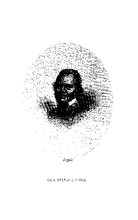
Description: Reprint. Originally published: St. Louis: Bryan, Brand, 1879.
Member of: All Books and Texts
Resource Type: Text
The Negroes of Columbia, Missouri: a concrete study of the race problem
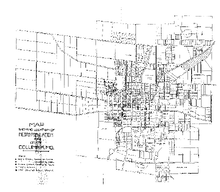
Description: LSO ID: umlc000007.,M.A. University of Missouri 1902.
Member of: Missouriana: History (Collection)
Resource Type: Text
Journal of a tour into the interior of Missouri and Arkansaw
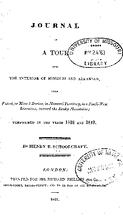
Description: Contains Transallegania, or The groans of Missouri : a poem / by H.R. Schoolcraft (p.[92]-102).,8vo: B-N4 O4( -O4).,LSO ID: umlc000013.,Original issued with: "Voyage from France to Cochin-China in the ship Henry / [by] Captain Rey, of Bordeaux, in the years 1819 and 1820": p. [103]-128.
Member of: Missouriana: History (Collection)
Resource Type: Text
Reminiscences of Company "H", First Arkansas Mounted Rifles

Description: LSO ID: umlr000066.nLSO ID: civr000066.nOCLC/WorldCat number: 5140373.
Member of: Missouriana: History (Collection)
Resource Type: Text
Letter of transmittal from the United States Treasury Department to the University of Missouri, May 18, 1912
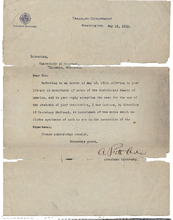
Description: Letter which accompanied the gift of Confederate Currency from the United States Treasury Department to the University of Missouri. The letter is dated May 18, 1912 and is signed by the Assistant Secretary of the Treasury, A. Piatt Andrew.
Member of: Confederate Currency enclosures
Resource Type: Text
JM-159: The value of ideals
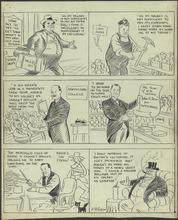
Description: Editorial cartoon depicting William Jennings Bryan lecturing to earn money in the aftermath of his loss in the 1900 senatorial election. Bryan charged $500 per speech or lecture, and he was the most popular speaker on the Chautauqua circuit from 1900 to 1912.
Member of: McCutcheon Editorial Cartoons - ALL (Collection)
Resource Type: Still Image
JM-190: America would like to know
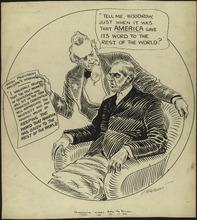
Description: Editorial cartoon depicting Uncle Sam questioning President Wilson about when "America gave its word to the rest of the world" while holding a paper containing a quotation from part of Wilson's interview.
Member of: McCutcheon Editorial Cartoons - ALL (Collection)
Resource Type: Still Image
JM-148: Japan objects to the weapon which he himself has never hesitated to use
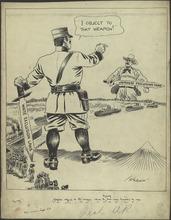
Description: This cartoon personifies United States relations with Japan in 1913. Japan is criticizing California for employing Japanese exclusion laws. These laws are most likely a reference to the California Alien Land Law of 1913. This law prohibited "aliens ineligible for citizenship" from owning agricultural land or possessing long-term leases, but permitted short-term leases lasting up to three years. This act was problematic for diplomatic relations with Japan, as it directly discriminated against Japanese citizens. This law also limited the number of Japanese immigrants to come to the US. While this law actually had little tangible backlash on Japanese citizens, it caused a large amount of tension between Japan and the US. Japan is also illustrated wielding the weapon of exclusion laws. In response to California's discrimination laws, Japan threatened to begin creating policies, which would discriminate against Americans. (Summary created by Mary Delano, MU History Intern, Spring 2018)
Member of: McCutcheon Editorial Cartoons - ALL (Collection)
Resource Type: Still Image
JM-188: New members of the club
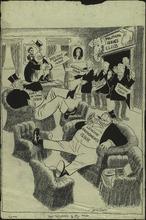
Description: This cartoon depicts many issues leading to political discourse during the late 1910s in the United States. The old sources of political discourse such as "prohibition issue", "he kept us out of war issue", and "tariff issue" have been displaced by the overgrown and overwhelming new issues. The "prohibition issue" refers to the question of whether alcohol should be a legal substance in the United States. The "he kept us out of war issue" refers to the fact that, despite his promise, the United States entered World War I under President Wilson. The "tariff issue" refers to what goods (if any) should have a tariff placed on them to protect the economic interests of the United States. The new issues overtaking the room were a relatively new source of political conflict. The "league amendments issue" refers to the United States entering the League of Nations. If the United States had joined the League of Nations, it would have to surrender some of its national sovereignty, which made it an unacceptable option to many politicians. The "cost of living" was a relatively new issue in the United States. It refers to the unusually high cost of necessary items, while many worker's wages remained low by comparison. The "daylight savings issue" refers to the issue of whether the United States should continue to use daylight savings time. The United States had adopted daylight savings time in 1918. Many countries adopted daylight savings during World War I as a way to lower the need to use coal. The transition to daylight savings time had been problematic, and many in the United States thought it should be abandoned. (Summary created by Mary Delano, MU History Intern, Spring 2018)
Member of: McCutcheon Editorial Cartoons - ALL (Collection)
Resource Type: Still Image
JM-132: Fifty years from now
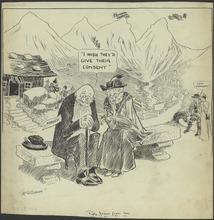
Description: This cartoon depicts an aged version of Katherine Elkins and Prince Luigi Amedeo, Duke of Abruzzi. Katherine Elkins was the daughter of Senator Stephen B. Elkins, an influential politician from West Virginia. The Duke of Abruzzi was Commander in Chief of the Italian fleet and fifth in line for the Italian throne. They met through a series of social events in the United States, and their courtship was covered by the Chicago Tribune and other newspapers for over two years. The Duke of Abruzzi needed the permission from the King of Italy to marry. If the couple had married without royal permission, then Ms. Elkins would not have received a royal title or estates and The Duke of Abruzzi would have received reprimand from the crown. When this cartoon was drawn, the Duke and Ms. Elkins were rumored to be engaged, but still waiting for the King's blessing to wed. Eventually, the King would deny this request and the couple separated around 1912. Katherine Elkins went on to marry Billy Hitt, the son of an Illinois congressman. The Duke Abruzzi led the Italian navy through World War I, and he oversaw the Italian colony of Somalia. The Duke of Abruzzi married as well, and died in 1933. (Summary created by Mary Delano, MU History Intern, Spring 2018)
Member of: McCutcheon Editorial Cartoons - ALL (Collection)
Resource Type: Still Image
JM-158: The President has important business in Massachusetts
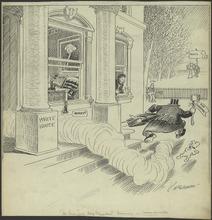
Description: This cartoon shows President Taft racing out of the White House with an ax for his predecessor, Theodore Roosevelt. While President Taft was in office, Theodore Roosevelt continued to remain active in policy. This cartoon was published with article indicating former President Roosevelt sought to protect International Harvester Company, which was in violation of the Sherman Antitrust Act. There had been a series of letter by Theodore Roosevelt published, which indicated Roosevelt was involved with encouraging the government to not pursue International Harvester Company. President Taft was leaving for Massachusetts to give a speech to denounce the actions of Theodore Roosevelt. President Taft also wished to remind the American people how much he had done to eliminate trusts to protect the American people. (Summary created by Mary Delano, MU History Intern, Spring 2018)
Member of: McCutcheon Editorial Cartoons - ALL (Collection)
Resource Type: Still Image
JM-130: Hello, Is that the coroner?
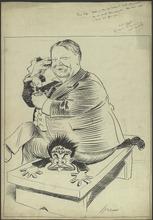
Description: This cartoon is an editorial depiction of the fear of war with Japan in later 1910. At the time, the army of Japan was growing, and they were seeking new technology and funding. This was combined with Japan seizing territory around it, such as parts of Korea. These military actions made relations between the United States and Japan more tense, even to the point where California was proposing legislation to limit the rights of Japanese citizens. The Chicago Tribune took a relatively relaxed approach to the situation, asserting relations between the United States and Japan were nowhere near a declaration of war. Journalists came to this conclusion, because the costs of war were too great for both sides. Ultimately, President Taft sought to avoid public fear by seeking to dismantle rumors of war by publicly announcing the United States intention of peace with Japan. This cartoon shows Taft crushing the personified Japanese war scare while on the phone saying "Hello, is that the coroner? Well, say, come up in about 10 minutes. I'll have a nice job for you." (Summary created by Mary Delano, MU History Intern, Spring 2018)
Member of: McCutcheon Editorial Cartoons - ALL (Collection)
Resource Type: Still Image
JM-136: Adjusting the Russian treaty difficulty

Description: This cartoon illustrates tense diplomatic relations between Russia and the United States in 1911. The Treaty of 1832 between the United States and Russia was created to give citizens of both countries specific rights such as economic freedoms or freedom of movement, whether they resided in Russia or the United States. Slowly beginning in the 1890s and continuing into the 1900s, Russia was limiting the rights of Jewish citizens from the United States. Eventually these citizens' United States passports were no longer accepted by the Russian government, which was clearly against the Treaty of 1832 (or the Treaty of Constantinople). Outraged by this breach, Congress issued the Sulzer Resolution, which called for the immediate nullification of the Treaty of 1832 due to Russia's violation of its contents. The first panel of the cartoon shows the beginning of the political tension between Russia and the United States. Russia was offended by the language of the Sulzer Resolution, stating they never fully violated the treaty. The second panel shows United States resentment of Russia's discrimination of their citizens. The third panel shows the United States compromising with Russia by changing the wording and nuance of the dispute to appeal to Russia's sensibilities. During this political tension, President Taft held a strong desire to maintain diplomatic relations with Russia. Despite Taft's efforts, diplomatic relationships between the United States and Russia remained strained due to a lack of compromise from either side. (Summary created by Mary Delano, History Intern, Spring 2018)
Member of: McCutcheon Editorial Cartoons - ALL (Collection)
Resource Type: Still Image
JM-193: If things only worked out according to the prospectus!
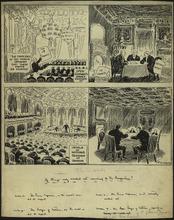
Description: The top left panel is captioned, "The Peace Conference, as the world was led to expect". The caption references Woodrow Wilson presenting his "14 Points" at the Paris Peace Conference in 1919. The Paris Peace Conference was held after the end of fighting in WWI, and resulted in the creation the Treaty of Versailles. The Treaty of Versailles was the document which formally ended WWI, and laid out the terms of surrender for the Axis powers. Wilson's "14 Points" speech outlined his ideas for peace to thrive after such a brutal and catastrophic war. The first point in Wilson's speech is "Open covenants of peace, openly arrived at, after which there shall be no private international understandings of any kind but diplomacy shall proceed always frankly and in the public view". The purpose of this point was to avoid the secret alliances that led to many countries becoming involved in WWI. The top right panel shows Wilson's "14 Points" in the trash and is captioned, "The Peace Conference as it actually worked out". The shows three men signing a secret treaty. Based on their appearances and the context of the cartoon these men are mostly likely President Woodrow Wilson (the left), Prime Minister of France, Georges Clemenceau (the middle), and Prime Minister of England,David Lloyd George (the right). The bottom shows a meeting of the League of Nations, and is captioned "The League of Nations, as the world is led to expect". The League of Nations was Woodrow Wilson's idea to create a body of the world's nations, which would foster international cooperation and support. The League of Nations is the fourteenth point in Wilson's "14 Points" being described as "A general association of nations must be formed under specific covenants for the purpose of affording mutual guarantees of political independence and territorial integrity to great and small states alike".The League of Nations operated from 1920 to 1946, and faced significant problems from nations having varying international interests. The bottom right panel shows five men sitting at a table with the caption, "The League of Nations if it follows the precedent set by the Paris Conference". (Summary created by Mary Delano, MU History Intern, Spring 2018)
Member of: McCutcheon Editorial Cartoons - ALL (Collection)
Resource Type: Still Image
JM-186: Three scenes about labor workers
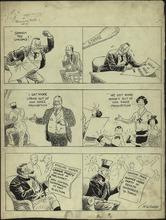
Description: This cartoon depicts three different scenes in separate panels. In the top panel, a business man is angry about workers' unions and wants them to be "smashed," but later, with the threat of a strike hovering over him, he signs his name on a wage increase form. Negotiation between workers and employers were becoming a more common occurrence in the 1910s. Unions and the notion of collective bargaining were beginning to be protected under the law. In the middle panel, a man's boss is happy to get more labor out of the man since prohibition. The man's family also claims to get more money out of him since prohibition, and the children show off their new shoes. This panel shows the desired result of prohibition, which was to eliminate the loss of prosperity and productivity associated with drunkenness.In the bottom panel, John Bull smiles while reading the English paper, which proclaims the growing labor party might control government at next election. Meanwhile, Uncle Sam reads an American paper, which proclaims the Farmer Labor Party has grown to contain three people. As Uncle Sam reads the paper, there is panic in the background. The Farmer Labor Party was a political party founded in 1920 from the larger, international workers' movement associated with communism. As Uncle Sam reads the paper, there is obvious panic in the background. This last panel shows the significant difference in culture between the United States and England. England, like many other European states, was learning to tolerate the labor parties, and it eventually adopted the new parties into their political landscape. The United States was hypersensitive to any hint of communism, due to fears of a workers' revolution. Unlike England, the United States constantly sought to limit the influence and growth of these labor parties as much as possible. This fear is seen by the Red Scare the United States experienced in the 1920s. The Red Scare spread mass fear of communism, and it sought to eliminate communism completely from American economics and culture. (Summary created by Mary Delano, MU History Intern, Spring 2018)
Member of: McCutcheon Editorial Cartoons - ALL (Collection)
Resource Type: Still Image
JM-169: He kept us out of war!
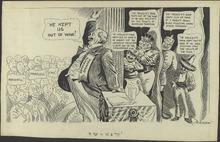
Description: This cartoon shows a democratic speaker addressing a crowd. The speaker is saying, "He kept us out of war", which was President Wilson's campaign slogan for the election of 1916 against Charles Hughes. There are various countries making comments behind the speaker. This first man on the left represents Japan. Japan is saying President Wilson would have gone to war with Japan, if he had allowed an act discriminating against Japanese immigrants in larger immigration legislation.The country next to Japan is England. England is saying that President Wilson would have entered World War I, if he had protected American shipping. This is a reference to the attack of an American ship, the Lusitania, by a German submarine. Japan and England were both Allied powers during World War I, and they are separated from the Axis powers, Germany and Mexico, by a wall. Germany is saying that President Wilson would not have needed to keep the United States out of war, if Germany had not been an aggressor against other nations. Next to Germany, Mexico is saying President Wilson would have declared war, if he had remained adamant on the salute if the flag. This refers to when President Wilson did not want to salute (and thus recognize) the Mexican government under the control of Victoriano Huerta. Despite his apprehension, President Wilson eventually returned the salute from a sense of precedent and duty. (Summary created by Mary Delano, MU History Intern, Spring 2018)
Member of: McCutcheon Editorial Cartoons - ALL (Collection)
Resource Type: Still Image
JM-151: The President is working on his message
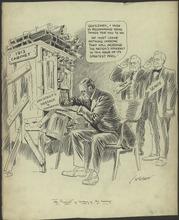
Description: This cartoon shows President Woodrow Wilson drafting his first States of the Union address to Congress. President Wilson was inaugurated on March 4, 1913, and he was the first president from the democratic party to be elected since Grover Cleveland left the office in 1897. President Wilson's desk with ideas he wishes to accomplish while in office. Woodrow Wilson was a leader in the Progressive movement, which proposed society could be improved through legislative reform. President Wilson took office shortly before the beginning of World War I on July 28, 1914. (Summary created by Mary Delano, MU History Intern, Spring 2018)
Member of: McCutcheon Editorial Cartoons - ALL (Collection)
Resource Type: Still Image
JM-183: Cartoonical miscellany
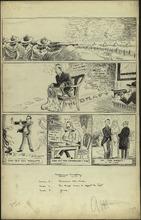
Description: Editorial cartoon depicting three different panels. The top one shows American soldiers fighting against German forces in World War I. The middle panel shows a man sitting in a chair with a horn blast blown by a soldier and the breeze begins to melt the man's frozen feet. The draft refers to the Selective Service Act of 1917, which forced men to enlist for military service. The bottom panel shows May leaving and June entering; a man sits at a desk writing an oration on "How to settle the war"; a man and a woman get married. June is the month in which two of the three registrations for the Selective Service Act of 1917 occurred. Students and married men also were given lower preference to draft in 1917. (Summary created by Mary Delano, MU History Intern, Spring 2018)
Member of: McCutcheon Editorial Cartoons - ALL (Collection)
Resource Type: Still Image
JM-152: Make the punishment fit the crime

Description: Editorial cartoon depicting a congressman proposing that an import duty of a thousand percent be levied on Parisian furniture and works of art, using Ex-Senator Nelson Wilmarth Aldrich as a punchline to talk about the Federal Reserve Act of 1913 that was strongly influenced by the Aldrich–Vreeland Act passed in response to the Knickerbocker Crisis of 1907.
Member of: McCutcheon Editorial Cartoons - ALL (Collection)
Resource Type: Still Image
JM-129: Will It be Conservative or Progressive?
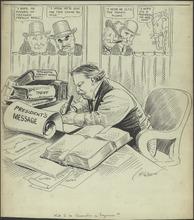
Description: This cartoon depicts President Taft creating a message regarding railroad freight rates. In the 1910, a large portion of goods was transported on railroads in the United States. Railroad owners made large profits by charging rates to ship cargo from one location to another. One of the books in the cartoon is titled, "injunction". This likely refers to the injunction granted by Judge David P. Driver against 25 western railroads located throughout the Midwest to the West Coast, who were all members of the Western Traffic Association. This injunction was granted in Hannibal, Missouri, as a result of an executive order from President Taft. This injunction prevented any of these railroads from raising or adjusting their rates in anyway. The special assistant to the Attorney General, Edwin Grosvenor, presented charges against these railroad companies in St. Louis, Missouri. These charges allegations of price-fixing and conspiracy between these companies to collectively raise rates. President Taft's administration is known for a hard stance against trusts. Taft's predecessor, President Theodore Roosevelt, began this practice during his own administration. Another project begun during President Roosevelt's administration: the construction and governance of the Panama Canal is also shown in this cartoon. (Summary created by Mary Delano, MU History Intern, Spring 2018)
Member of: McCutcheon Editorial Cartoons - ALL (Collection)
Resource Type: Still Image
JM-135: Busy days for the professional stock trader
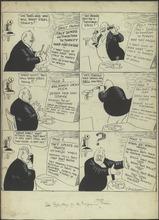
Description: Editorial cartoon depicting a stockbroker trying and failing to predict trends in the stock market.
Member of: McCutcheon Editorial Cartoons - ALL (Collection)
Resource Type: Still Image
JM-185: Tag day

Description: This cartoon depicts two people asking for money. The top panel shows a woman collecting money for the poor and destitute on Tag Day. Tag Day is a day where people will collect money for a charity, and donors will receive a tag showing they donated. The caption for this panel says to remember the children of the poor when being ask the give. The bottom panel shows an officer asking the same man to purchase a liberty loan subscription. These were bonds distributed by the government that were used to support the war effort. In 1917, the United States was a member of the Allied Powers in World War I, which included France, England, Italy, etc. The This panel is captioned, "Don't forget your own children when you are asked to subscribe for Liberty bonds". The man is more skeptical of this purchase than of his donation on Tag Day. (Summary created by Mary Delano, MU History Intern, Spring 2018)
Member of: McCutcheon Editorial Cartoons - ALL (Collection)
Resource Type: Still Image
JM-150: Japanese Haggling
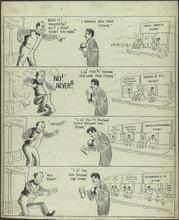
Description: This cartoon depicts a Japanese immigrant attempting to buy property from a white man. As negotiations continue, more Japanese owned stores appear in the background of the the cartoon.Eventually the white man's disposition shifts from enraged to eager as he finally accepts the offer. This cartoon is offering perspective on the relationship between Japanese immigrants and white Americans in the United States, particularly California. The California Alien Land Law of 1913 was passed the same year this cartoon was created.This law prohibited "aliens ineligible for citizenship" from owning agricultural land or possessing long-term leases, but permitted short-term leases lasting up to three years. This law did not have a large tangible impact on Japanese citizens. However, the law remains relevant, because it reflects the discrimination against Japanese immigrants occuring in the 1910s. (Summary created by Mary Delano, MU History Intern, Spring 2018)
Member of: McCutcheon Editorial Cartoons - ALL (Collection)
Resource Type: Still Image
JM-187: Political
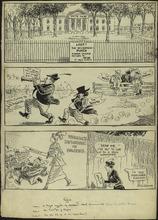
Description: This cartoon depicts various events during the Wilson administration. The top two panels imply a lack of force of the part of President Wilson. After World War I, President Wilson was an outspoken advocate for peace. One of his proposals to accomplish peace was the League of Nations. The League of Nations was an international body, which sought diplomacy and compromise between nations. The United States would never join the League of Nations, because many felt the League would compromise the sovereignty of the United States. The bottom panel of the cartoon shows a woman worrying about meeting the high standards set before her. In 1920, the United States government passed the 19th Amendment, which gave women the right to vote. Women had first found a place in politics by engaging with moral and/or social issues such as education, prohibition, and abolition. By continuing to take a role as protectors of morality women were able to gain enough support to win the right to vote. While the federal government did not allow women to vote in elections until 1920, some states allowed women to vote in state elections. (Summary created by Mary Delano, MU History Intern, Spring 2018)
Member of: McCutcheon Editorial Cartoons - ALL (Collection)
Resource Type: Still Image
JM-138: Well, Gentlemen
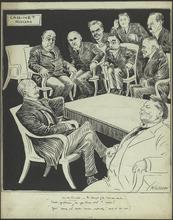
Description: This cartoon depicts Richard Achilles Ballinger, the Secretary of Interior, sweating during a cabinet meeting with President Taft. Ballinger was part of a controversial affair in 1910 that went down in history as either the Pinchot-Ballinger Controversy or the Ballinger Affair. The Ballinger Affair began over an investigation into Clarence Cunningham, who was suspected of illegally transferring land ownership in Alaska to commercial third parties. This investigation began under the Roosevelt administration. Ballinger, the General Land Office Commissioner, eventually concluded the investigation without the approval of his the Secretary of Interior, as he was required. Ballinger left his position for private practice as Cunningham's personal counsel, but he returned to served as Secretary of Interior under President Taft. Ballinger tried to resolve the allegations against Cunningham, but faced great backlash from other members of the administration, including Chief Forester, Gifford Pinchot. Pinchot, among others, accused Ballinger of negligence and endangering public lands. A committee was formed to determine Ballinger's guilt. With the exception of one Republican, all the Republicans on the committee ruled in favor of Ballinger, and all the Democrats on the committee ruled against Ballinger. The Ballinger Affair led to mass criticism of the Taft administration.The dispute between Ballinger and United States Forest Service Chief Gifford Pinchot that contributed to the split of the Republican party before the 1912 presidential election. (Summary created by Mary Delano, MU History Intern, Spring 2018)
Member of: McCutcheon Editorial Cartoons - ALL (Collection)
Resource Type: Still Image
JM-131: Well, I think I am going to have a white Christmas
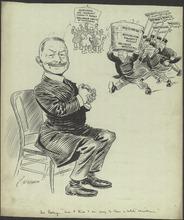
Description: This cartoon depicts Richard Achilles Ballinger, the Secretary of Interior, acting smug over the whitewashed Republican majority report that declares him guiltless while the Democratic insurgent minority report declares him guilty and unfit. Ballinger was part of a controversial affair in 1910 that went down in history as either the Pinchot-Ballinger Controversy or the Ballinger Affair. The Ballinger Affair began over an investigation into Clarence Cunningham, who was suspected of illegally transferring land ownership in Alaska to commercial third parties. This investigation began under the Roosevelt administration. Ballinger, the General Land Office Commissioner, eventually concluded the investigation without the approval of his the Secretary of Interior, as he was required. Ballinger left his position for private practice as Cunningham's personal counsel, but he returned to served as Secretary of Interior under President Taft. Ballinger tried to resolve the allegations against Cunningham, but faced great backlash from other members of the administration, including Chief Forester, Gifford Pinchot. Pinchot, among others, accused Ballinger of negligence and endangering public lands. A committee was formed to determine Ballinger's guilt. With the exception of one Republican, all the Republicans on the committee ruled in favor of Ballinger, and all the Democrats on the committee ruled against Ballinger. The Ballinger Affair led to mass criticism of the Taft administration.The dispute between Ballinger and United States Forest Service Chief Gifford Pinchot that contributed to the split of the Republican party before the 1912 presidential election. (Summary created by Mary Delano, MU History Intern, Spring 2018)
Member of: McCutcheon Editorial Cartoons - ALL (Collection)
Resource Type: Still Image
JM-142: Political methods, old and new
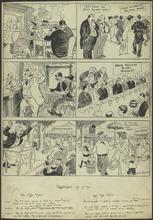
Description: This cartoon illustrates a comparison between "old" and "new" styles of politics in the United States. The men shown in the left panels represent political bosses who sought to influence elections for their own benefit. The people portrayed on the right panels display a more modern approach to politics. This approach included more open and transparent campaigns, and women were allowed to participate in a limited capacity. The political bosses appear confused at this new way of engaging politics. The "old way" of politics shows the bosses holding primary elections only amongst themselves, buying drinks for other men, and consuming excessive amounts of alcohol. The "new way" of politics shows men and women enjoying parties, banquets, and picnics in a family-friendly environment. The political bosses are shocked and confused to see how politics has changed overtime. The shift in politics occurred as women became more involved with political initiatives such as abolition or prohibition. (Summary created by Mary Delano, MU History Intern, Spring 2018)
Member of: McCutcheon Editorial Cartoons - ALL (Collection)
Resource Type: Still Image
JM-189: Compromises
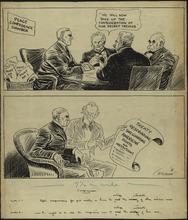
Description: The top panel of this cartoon depicts President Woodrow Wilson meeting with other world leaders at the Paris Peace Conference in 1919. The Paris Peace Conference began after the armistice agreement for World War I, and it eventually produced the Treaty of Versailles. The four men meeting depict the leaders of the "Big Four" Allied powers of WWI. The Big Four nations were the United States, led by President Woodrow Wilson, England, led by Prime Minister David Lloyd, France, led by Prime Minister Georges Clemenceau, and Italy, led by Prime Minister Vittorio Orlando. These men are creating secret treaties, which is in contradiction with Wilson's "14 Points" speech. The first point in this speech is "Open covenants of peace, openly arrived at, after which there shall be no private international understandings of any kind but diplomacy shall proceed always frankly and in the public view". This point was created to address the practice of secret treaties between nations, which many contributed to the beginning of World War I. The 14 points are conspicuously placed in the garbage at this meeting. The bottom panel depicts Uncle Sam showing Woodrow Wilson ways to protect the United States while signing treaties with other nations. This panel is captioned, "he ought to be able to compromise now to satisfy the interests of his own". This caption is used to suggest there may have been conflict between President Wilson's interests and the interests of the United States. (Summary created by Mary Delano, MU History Intern, Spring 2018)
Member of: McCutcheon Editorial Cartoons - ALL (Collection)
Resource Type: Still Image
JM-182: The new income tax
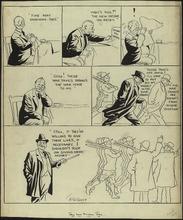
Description: This cartoon depicts a man being irritated with the high income tax rates in the United States. The man suggests the reason for the increased taxes is the fact the the United States is currently fighting in World War I. The man continues to complain about the income tax until he passes a group of soldiers. The man realizes his financial sacrifice is less than that being made by the men serving in the military. (Summary created by Mary Delano, MU History Intern, Spring 2018)
Member of: McCutcheon Editorial Cartoons - ALL (Collection)
Resource Type: Still Image
JM-021: Mr. American reactionary abroad tries to change the opinion of Europe

Description: Editorial cartoon depicting an American visiting places such as France, Germany, and Italy and hearing praise for Roosevelt, which the American does not agree with.
Member of: McCutcheon Editorial Cartoons - ALL (Collection)
Resource Type: Still Image
JM-065: Our present divorce laws
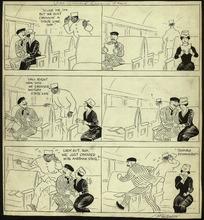
Description: Editorial cartoon depicting a couple being warned by a train worker and moving to sit together or apart depending on what state the train is passing through.
Member of: McCutcheon Editorial Cartoons - ALL (Collection)
Resource Type: Still Image
JM-149: Conundrum of the California Alien Land Law
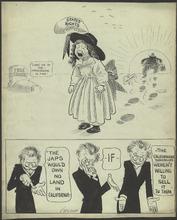
Description: The top panel of this cartoon depicts a little girl, "states' rights" crying over the grave of free silver. "Free silver" refers to the concept of the free coinage of silver, which was a popular idea for public policy among populists and other groups. Those in favor of free coinage of silver would argue that it would increase the circulation of currency, which would make wages higher and loan easier to obtain. Those against the free silver policy typically supported the gold standard, which was officially adopted by the United States in 1879. The gold standard limits the coinage of silver and other currency in circulation, because all currency must defined in the value of gold. Proponents of the gold standard argued it stabilized American currency, which allowed business to function. William Jennings Bryan, an influential American politician and Secretary of State (1913-1915), was an outspoken supporter of the free silver policy. In the top panel, William Jennings Bryan is abandoning states rights to go to California. William Jennings Bryan became involved with attempting to block discriminatory legislation against Japanese immigrants in California, such as the California Alien Land Law. This law placed restrictions of Japanese immigrants' legal ability to acquire and own property. Such discriminatory laws created a tense diplomatic relationship with Japan. As Secretary of State, William Jennings Bryan attempted to limit the impact of such legislation to improve relations between the United States and Japan. The idea behind many of these discriminatory laws in seen in the bottom panel. (Summary created by Mary Delano, MU History Intern, Spring 2018)
Member of: McCutcheon Editorial Cartoons - ALL (Collection)
Resource Type: Still Image
JM-170: Getting scareder and scareder!
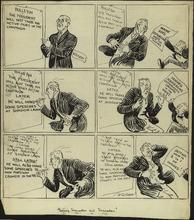
Description: This cartoon depicts President Woodrow Wilson planning his reelection campaign against Charles Evans Hughes during the presidential election of 1916. The first panel shows President Wilson calmly planning to take a passive role in the campaign until he receives a note that the state of Maine voted for Hughes by a narrow majority. The second panel shows a concerned Wilson receiving news that Hughes was addressing crowds in the West, whose vote Wilson was counting on for winning the election. The third panel shows a shocked Wilson learning Hughes was predicted to win the election by a large margin. Despite the assumptions made in this cartoon, Woodrow Wilson would defeat Hughes in the election of 1916, and he became the first democratic president to serve two consecutive terms in a row since Andrew Jackson. Woodrow Wilson appealed to many with his campaign slogan, "He kept us out of war," which appealed to many European (especially German) immigrants who did not wish to have the conflict of loyalty that would come from the United States joining World War I. Despite this, the United States would eventually enter World War I in 1917 during Wilson's second term. The Chicago Tribune published many articles in support of Hughes and his campaign. (Summary created by Mary Delano, MU History Intern, Spring 2018)
Member of: McCutcheon Editorial Cartoons - ALL (Collection)
Resource Type: Still Image
JM-175: Don't drop the pilot!
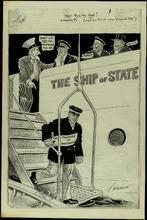
Description: This cartoon show Uncle Sam talking with President Wilson, Force, and Politics. Uncle Sam is insisting these parties do not allow someone to take the principle of arbitration outside the "ship of the state". Arbitration is a form of dispute resolution that gained popularity during the world wars. It was a quick and efficient way to resolve personal and commercial disputes without the time and effort associated with moving a claim through the traditional judicial system. The United States government began to use arbitration as a way to efficiently solve disputes involving wartime resources. (Summary created by Mary Delano, MU History Intern, Spring 2018)
Member of: McCutcheon Editorial Cartoons - ALL (Collection)
Resource Type: Still Image
JM-176: The daily bread line 1913
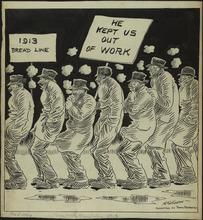
Description: This cartoon depicts a line of men waiting for food during the winter. One of them is holding a sign that says, "He kept us out of work". This sign is a play on President Wilson's campaign slogan, "He kept us out of war". There were some areas of United States economy struggling in 1913, making many individuals unemployed. In 1913, many criticized President Wilson's economic initiatives to be harmful to workers, and contributing to increased in unemployment. Such initiatives included further limiting commercial trusts and requiring investigations be made when particular businesses changed the wages of their workers. These investigations would be used to evaluate the costs of the factories, which was needed to determine guilt of criminal acts. In response to these initiatives, many factories closed operations or began to limit the changes that could be made to workers' wages. (Summary created by Mary Delano, MU History Intern, Spring 2018)
Member of: McCutcheon Editorial Cartoons - ALL (Collection)
Resource Type: Still Image
JM-161: The refining influence of speculating in war stock
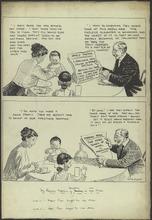
Description: This cartoon shows two impressions of the same family living in the United States during World War I. The top panel displays the family before they bought war stocks. The bottom panel shows them after they purchased war stocks. In the top panel, the mother and father are lamenting on the carnage of the war, causing the death of millions in Europe. The couple is horrified at the seemingly senseless loss of life. In the bottom panel, the couple are thrilled the war is expected to drag on, because the value of their war stocks will continue to increase and provide a temporarily sustained income to the family. This cartoon is meant to illustrate Americans' disturbing lack of empathy at the mere promise of profit. The United States notoriously made large profits throughout most of World War I selling weapons to use in the war, while remaining neutral in the conflict until 1917. (Summary created by Mary Delano, MU History Intern, Spring 2018)
Member of: McCutcheon Editorial Cartoons - ALL (Collection)
Resource Type: Still Image
JM-180: In the national army parade today, you are likely to see the man you'll all be cheering and voting for in years to come
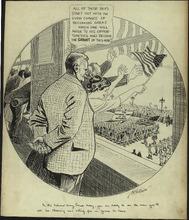
Description: This editorial cartoon depicts people watching the National Army of the Republic parade outside the window. A man wonders who will be "the Grant of this war." This is most likely one of the many parades held by military forces while the United States was fighting in WWI. This cartoon is captioned. "In the National Army Parade today, you are likely to see the man you'll all be cheering and voting for in years to come". The "Grant of this war" is a clear reference to Ulysses Grant, the eighteenth president of the United States from 1869 to 1977. Ulysses Grant was a general in the Civil War, and he is often given much credit for the Union's victory. After being appointed General-in-Chief by Abraham Lincoln in 1864, Grant would accept General Lee's surrender at Appomattox Court House, which effectively ended the Civil War. This cartoon suggests the future leaders of the United States would likely have served in World War I. (Summary created by Mary Delano, MU History Intern, Spring 2018)
Member of: McCutcheon Editorial Cartoons - ALL (Collection)
Resource Type: Still Image
JM-137: 1912 Presidential Election

Description: This cartoon illustrates the events that occured in the presidential election of 1912. The top left panel shows former president, Theodore Roosevelt, obviously beating Taft in the primary elections. This reflected the fact that most voters at the time preferred Theodore Roosevelt to President Taft for reelection. The top right panel shows President Taft winning the primary election, because Roosevelt has been tackled by the credentials committee. The credentials committee was responsible for determining, which men were eligible to vote in the primary elections of 1912. The middle panel shows nominations for the Republican primary. The nomination of the left is for former President Theodore Roosevelt. The nomination on the right is for Charles Evans Hughes, former governor of New York. The bottom panel shows the race continuing, and a group of men sitting in a room. (Summary created by Mary Delano, MU History Intern, Spring 2018)
Member of: McCutcheon Editorial Cartoons - ALL (Collection)
Resource Type: Still Image
JM-128: Shake hands with my friend, Canadian Reciprocity
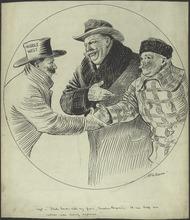
Description: Editorial cartoon depicting William Howard Taft encouraging a free trade accord between the Midwest and Canada.
Member of: McCutcheon Editorial Cartoons - ALL (Collection)
Resource Type: Still Image
JM-145: The Senate passes a parcels post bill
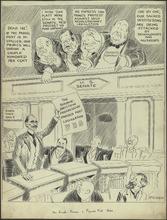
Description: This cartoon shows the US Senate passing the Post Office Appropriation Bill of 1912. The most controversial part of this legislation was the parcels post provision being held up in the comic. This provision divided the country into zones, which would be used to determine postage prices in the US. The provision was introduced by Senator Jonathan Bourne of Oregon to create uniform postage prices within specific areas of the United States. Senator Joseph Bristow of Kansas originally objected to the provision, claiming the price proposals of postage were too low to sustain. Eventually, the senators reached a compromise and the bill was passed with the maximum postage rate of 12 cents per first pound shipped within the total of eight zones created. This bill was thought to be beneficial to small businesses, regularized and lowering costs in specific zones. This bill was not well received by many within the US, particularly with some big business, as represented by the four large men in the top of the cartoon. One of these men reference former Senator Thomas Platt, an infamous political boss for the Republican party. The comment shows a shift occurring within Congress from conservative to more progressive policies during the 1910s. This shift is seen by the man commenting, "Darn those daily moosepapers". This comment is most likely a reference to the progressive policies of President Theodore Roosevelt, who founded the Bull-Moose party in 1912. (Summary created by Mary Delano, MU History Intern, Spring 2018)
Member of: McCutcheon Editorial Cartoons - ALL (Collection)
Resource Type: Still Image
JM-162: Why the U. S. must be strictly neutral
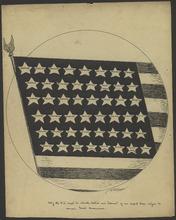
Description: This comic depicts the United States flag having forty eight stars, because Hawaii and Alaska would not become states until 1959. Each star has a ethnicity or nationality listed on it to represent the different types of immigrants assimilating and/or remaining in the United States after moving from different locations. The quote below the comment reads, "Why the US must be strictly neutral and tolerant if we expect these citizens to remain good Americans." This cartoon suggests that if the United States were to enter World War I, it would outrage the immigrants of the countries upon which the United States declared war. This was a common concern of United States citizens before the United States entered World War I. (Summary created by Mary Delano, MU History Intern, Spring 2018)
Member of: McCutcheon Editorial Cartoons - ALL (Collection)
Resource Type: Still Image
JM-160: The Christmas Carol that was not rehearsed
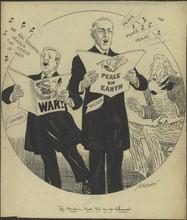
Description: This cartoon highlights and humorizes the lack of agreement between President Woodrow Wilson and his Secretary of State, Robert Lansing. In December of 1916, President Wilson issued a peace note, explaining his position on the United States involvement in World War I. President Wilson wished to help negotiate peace talks between the allies and Germany, which had been recently suggested by Germany. President Wilson also wished to keep the United State a neutral party within World War I, not providing military support to either side. In this peace note, Lansing offered an addendum saying, "The United States already in the war economically, was being drawn in militaristically." This caused a great upset in the Wilson administration as the President tried to emphasize the need for peace without completely discrediting his Secretary of State. The cartoon highlights this discomfort by showing Lansing and President Wilson essentially singing a different tune. A shocked Uncle Sam (citizens of the United States) sits listening to the pair and is unsure what to think of the spectacle. This cartoon uses Christmas carols as a humorous reminder that this incident occurred within the week before Christmas in December of 1916, less than six months before the United States would eventually enter World War I. (Summary created by Mary Delano, MU History Intern, Spring 2018)
Member of: McCutcheon Editorial Cartoons - ALL (Collection)
Resource Type: Still Image
JM-164: Will there be enough to go round?
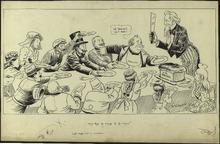
Description: This cartoon depicts Uncle Sam trying to divide "U.S. Bread" among various nations. In 1915, World War I was being fought in Europe, but the United States was maintaining a neutral position. Despite its neutrality, the United States supplied resources and arms to nations during the war. All of the countries sitting at the table are nations who lobbied for resources from the United States during the war. England is attempting to block Germany's chance of receiving resources from Uncle Sam. This is representative the attempts of the British government to limit the United States aid to Allied Powers, most often England. The United States is also sitting at the table, looking worried about sharing the beard with other nations. The United States distributing more resources than it could afford was a fear for many Americans in the 1910s. (Summary created by Mary Delano, MU History Intern, Spring 2018)
Member of: McCutcheon Editorial Cartoons - ALL (Collection)
Resource Type: Still Image
JM-141: The great spring take-off
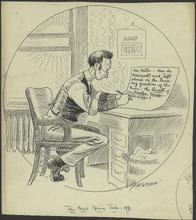
Description: This is a satirical piece commenting on a series of tariffs on fabrics, especially those used in the clothing industry. A tariff on cotton caused great outrage among the middle class, especially women. Most antagonists of the bill stated cotton was too essential to clothe the people of the United States to unnecessarily drive up the cost. Unlike other fabrics, wool had been able to move through the United States without having a new tariff placed upon it. It appeals to the common man's (and woman's) feelings of the lack of need for wool rather than cotton esp in the summer months like May. The author is writing to hear then President Taft's and former President Roosevelt's opinions. This is because President Taft and his former leader, Theodore Roosevelt both favored the passed tariffs on fabrics. President Taft himself signed the tariff on cotton and was heavily in favor of supporting tariffs rather than income taxes, which were just beginning to be commonly employed in the United States. (Summary created by Mary Delano, MU History Intern, Spring 2018)
Member of: McCutcheon Editorial Cartoons - ALL (Collection)
Resource Type: Still Image
JM-191: Don't wreck that car!
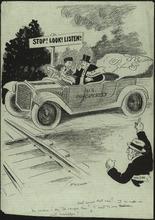
Description: This cartoon shows railroad employees fighting with railroad employers in a car named "U.S. Prosperity", which is carrying the United States in the back seat. There were many railroad employee strikes in the first half of the twentieth century, usually protesting against poor pay and/or working conditions. Railroads were one of the most efficient methods of transportation, especially the transportation of goods. This made railroads critical to the health of the United States economy. In the corner of this cartoon, President Woodrow is yelling at the employers and employees to not wreck the car. While the role was not extensive, the government did take an interest in these railroad disputes, and made sure they were eventually settled. This intervention was usually performed to ensure the railroads would continue to ship American goods throughout the United States. (Summary created by Mary Delano, MU History Intern, Spring 2018)
Member of: McCutcheon Editorial Cartoons - ALL (Collection)
Resource Type: Still Image
JM-173: National defense
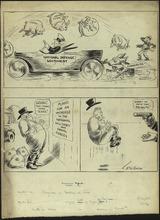
Description: The top panel of this cartoon depicts Congress attempting to slow Uncle Sam driving a automobile and is used to represent the fast moving sentiments for national defense. The donkey is being used to suggest the actions of Congress are aligned with the democrat interests of the time. National defense is passing through pork and casting it to the side. The word "pork" is being used to describe projects and/or funding given by Congress to benefit certain areas or populations in the country. An example of pork would be Congress awarding money for a damn to be built in a specific state. The bottom panel has two possibilities that stem from the sentiments of the top panel. The scenario on the left depicts a man dissatisfied with increased taxes that Congress would have to impose to fund national defense interests. The scenario on the right shows the same man having to pay tributes to an invader. The bottom panel suggests that tax increases for national defense are in the best financial and personal interest of citizens. (Summary created by Mary Delano, MU History Intern, Spring 2018)
Member of: McCutcheon Editorial Cartoons - ALL (Collection)
Resource Type: Still Image
JM-143: Awkward mistake in the date
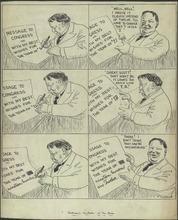
Description: This cartoon portrays President Taft writing a message to Congress. In 1912, President Taft ran for reelection, most notably campaigning against his predecessor, Theodore Roosevelt, in the Republican primary. President Taft would eventually win the Republican primary. After losing that election, Roosevelt ran for president after creating his own party, the Bull-Moose party. The campaigning between Roosevelt and Taft was rigorous, and they ultimately split the the Republican vote in the 1912 presidential election. (Summary created by Mary Delano, MU History Intern, Spring 2018)
Member of: McCutcheon Editorial Cartoons - ALL (Collection)
Resource Type: Still Image
JM-181: Long speeches by those pictured
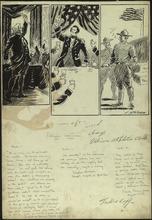
Description: This cartoon compares three speeches. The first speech on the left was Patrick Henry's famous speech, in which he stated "Give me liberty or give me death!". This speech was given on the eve of the Revolutionary War. The second speech was by Stephen Decatur, a commodore in the United States Navy. Decatur's speech was given at the conclusion of the War of 1812. The final speech was given by Private Sammy Jones during World War I. (Summary created by Mary Delano, MU History Intern, Spring 2018)
Member of: McCutcheon Editorial Cartoons - ALL (Collection)
Resource Type: Still Image
JM-168: Long distance driving
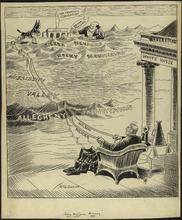
Description: Editorial cartoon depicting Wilson holding reins titled "Wilson policies" of a donkey heading toward the San Francisco Convention, where Bryan is placing a flag of his policies.
Member of: McCutcheon Editorial Cartoons - ALL (Collection)
Resource Type: Still Image
JM-144: Peace Talk
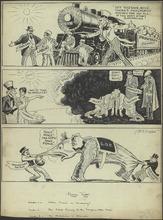
Description: In the first panel, capital and labor are in an argument. This is a personification of the series of labor disputes between workers and large business owners that were a common product of the Industrial Revolution. Usually these disputes were about implementing better employment practices such as better wages, workers' compensation, safety regulations, etc. This argument is delaying the train of 1916, which holds the economic prosperity the United States experienced due to it funding and manufacturing supplies for the European nations fighting in World War I. Uncle Sam, the United States, is attempting to resolve the conflict between Labor and Capital, so they can become ready to experience the prosperity 1916 is bringing. Notice the bottom notation says this "peace" is necessary. The second panel portrays a wide view of the world with the United States on the left and Europe on the right. On the left, Uncle Sam (the United States) is being asked by humanity to intervene and mediate in Europe. This exchange references those who thought the United States had a moral duty to help end World War I in Europe. On the right side of the panel, is a depiction of the World War I conflict being shielded from the glow of peace (the sun). The Allies (Britain, France, Italy) are fighting with the Teutons (Germany and its allies with Germanic roots). Looming over this fight are the personifications of financial and physical death. This shows the devastation World War I has caused in Europe. The last panel depicts the internal debate between politicians in the US about what action should be taken regarding European intervention. On the left, "progressive" politicians pull the elephant ( the Republican party) towards peace, meaning they want the US government to help European nations negotiate a peace. Notice the Progressive politician is dressed in relatively simple clothing, which suggests he appeals more the common man. The "old guard" politician is pulling the Republican party away from peace, meaning he wishes the United States to remain neutral and not intervene in World War I. He is dressed more upscale, which suggests his ideas represent the older, more wealthy population that is profiting on the war. (Summary created by Mary Delano, MU History Intern, Spring 2018)
Member of: McCutcheon Editorial Cartoons - ALL (Collection)
Resource Type: Still Image
JM-140: Proposed solution to the disputed problem
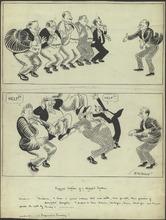
Description: This cartoon depicts the potential candidates for the Republican primary election of 1912. The first candidate portrayed on the left is President Taft, who was running for re-election. The second candidate is James Sherman's, President Taft's former vice president. The next candidate is a senator from Massachusetts, Boies Penrose. William Barnes, Jr., a politician and journalist from New York, is displayed as a potential runner. The last candidate depicted in the cartoon is Winthrop Crane, another senator from Massachusetts. All these men appear to be eager to run in the Republican primary in the top panel. However, some of these men are accused of being fraudulent candidates. This means they have been accused of not actually been favored by the public to run for the presidency To ensure their legitimacy, a man suggests a preferential primary. A preferential primary is an election that determines the nominee for the presidency through the preference of voters or through delegates (these delegates most vote for the winning primary candidate). The practice of a preferential primary contradicts against the tradition of political bosses attempting to organize the outcome of elections. The candidates of the elections all find this news distressing in the bottom panel. (Summary created by Mary Delano, MU History Intern, Spring 2018)
Member of: McCutcheon Editorial Cartoons - ALL (Collection)
Resource Type: Still Image
JM-139: For chairman of the convention
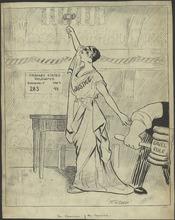
Description: This cartoon shows Lady Justice presiding over the Republican Convention for the 1912 primary election. Former president, Theodore Roosevelt, was running against president incumbent Taft. President Roosevelt seems to have more delegate votes than Taft, but Taft would ultimately be renominated for the presidency. Roosevelt claimed Taft stole delegates that should have been awarded to him, making him lose the election. After losing the Republican primary, Theodore Roosevelt began his own party, the Bull-Moose Party. Taft and Roosevelt would eventually split the Republican vote, which allowed Woodrow Wilson to be elected as president in 1912. (Summary created by Mary Delano, MU History Intern, Spring 2018)
Member of: McCutcheon Editorial Cartoons - ALL (Collection)
Resource Type: Still Image
JM-184: Peace talk

Description: The cartoon shows the interpreted process of peace talks during World War I. The top panel shows the German people being dragged to peace by the Kaiser Wilhelm II. The second panel shows the Reichstag calling for peace after the kaiser orders them to begin discussions. In 1917, the United States had entered World War I, and Germany's and the Axis powers' chance of victory was becoming smaller and smaller. This made them more willing to negotiate for peace than in previous years of the war. The third panel shows the American stock market falling in value. This drop in the stock market was caused by the peace talks. Supplying weapons and other resources in World War I significantly improved the economy of the United States. Many factories and other means of productions had been created solely to meet the needs of the global conflict. As World War I came to a close, the United States large profits from the war effort began to decline. (Summary created by Mary Delano, MU History Intern, Spring 2018)
Member of: McCutcheon Editorial Cartoons - ALL (Collection)
Resource Type: Still Image
JM-202: Cartoons of the day
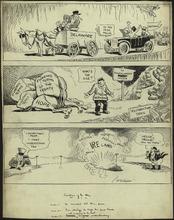
Description: Editorial cartoon depicting three separate cartoons. In the top panel, a man on a cart titled "Delaware" blocks women in cars titled "Suffrage" from passing him on the road to the 1920 polls. In the middle panel, "Germany" kills his pack horse ("Hope") underneath a burden of "Economic Terms of the Treaty"; he is unable to continue on "Reparation Trail". In the bottom panel, Uncle Sam and John Bull attempt to communicate via telephone, but uproar in Ireland blocks connection.
Member of: McCutcheon Editorial Cartoons - ALL (Collection)
Resource Type: Still Image
JM-090: Grosvenor and Platt present different views on McKinley
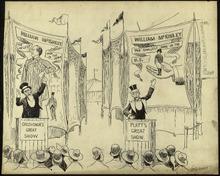
Description: Editorial cartoon depicting Charles Henry Grosvenor and Thomas C. Platt presented as sideshow hawkers speaking to a group of people. They each point to a large banner focusing on President William McKinley behind them. On Grosvenor's banner, McKinley is presented as the "largest man in the world." On Platt's banner, McKinley is presented as the "smallest man in the U.S."
Member of: McCutcheon Editorial Cartoons - ALL (Collection)
Resource Type: Still Image
JM-295: Sunken ships are historic trouble-breeders
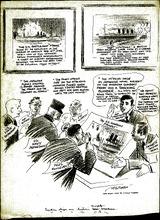
Description: Editorial cartoon depicting a group, including FDR, examine sinking of U.S. gunboat Panay.
Member of: McCutcheon Editorial Cartoons - ALL (Collection)
Resource Type: Still Image
JM-204: As Uncle Sam prepares to get back in the European game
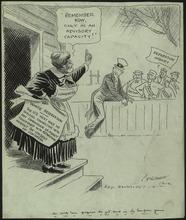
Description: Editorial cartoon depicting Uncle Sam being warned to participate only in an advisory way by U.S. Congress as he climbs over a fence to join a European Reparation Committee.
Member of: McCutcheon Editorial Cartoons - ALL (Collection)
Resource Type: Still Image
JM-220: If there was referendum on war debt cancellation
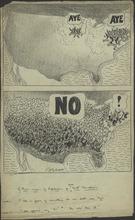
Description: Editorial cartoon depicting the outcry against a referendum on the collection of war debts in the aftermath of WWI.
Member of: McCutcheon Editorial Cartoons - ALL (Collection)
Resource Type: Still Image
JM-206: Three scenes of hypocrisy
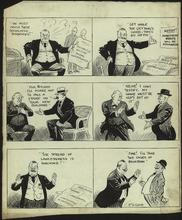
Description: Editorial cartoon depicting three panels, each panel with its own scene of hypocrisy. In the top panel, a man upset by socialists and unemployment then posts a notice for his apartment complex advancing the rent for his tenants to get their money while he can. In the middle panel, a man is being bribed but refuses to testify against the one bribing him. In the bottom panel, a man is shocked by the spread of lawlessness, but then he buys two cases of bourbon during a potential prohibition-era cartoon.
Member of: McCutcheon Editorial Cartoons - ALL (Collection)
Resource Type: Still Image
JM-268: Supposing American tourists in France tried to adopt the stalling on the payment plan
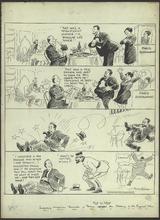
Description: Editorial cartoon depicting an American tourist finishing a large meal at a French restaurant. When he is handed the bill, he offers to pay for it on condition that another man who owes him money pays him back. The restaurant owner kicks the tourist out, and a policeman comes over and asks what happened.
Member of: McCutcheon Editorial Cartoons - ALL (Collection)
Resource Type: Still Image
JM-201: Making a bad situation worse
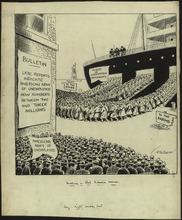
Description: Editorial cartoon depicting undesirable immigrants coming off a ship near Ellis Island while an army of the unemployed Americans watch them.
Member of: McCutcheon Editorial Cartoons - ALL (Collection)
Resource Type: Still Image
JM-039: The radio vote of America
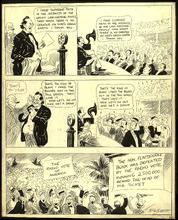
Description: Editorial cartoon depicting a politician giving a radio speech. After the speech, his derogatory comments about the American people are overheard, and he is defeated by the greatly populated "Radio Vote", which is shown in the last panel.
Member of: McCutcheon Editorial Cartoons - ALL (Collection)
Resource Type: Still Image
JM-121: Come on in, Boys! It's Finable Out There.
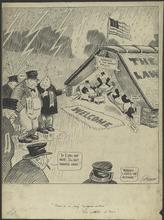
Description: Editorial cartoon depicting good men, sheltered by the letter of the law, calling to unhappy criminals outside in the rain.
Member of: McCutcheon Editorial Cartoons - ALL (Collection)
Resource Type: Still Image
JM-008: "I wish I had waited"
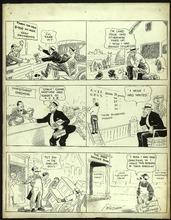
Description: Editorial cartoon depicting three scenes of men who purchased land, stocks, or furniture in the first panel only to express their disappointment in the second panel, when things are rough and what they have has decreased in value.
Member of: McCutcheon Editorial Cartoons - ALL (Collection)
Resource Type: Still Image
JM-237: Labor day
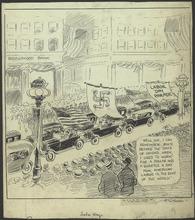
Description: Editorial cartoon depicting a Labor Day parade with a flag that has a Swastika made of hands on it.
Member of: McCutcheon Editorial Cartoons - ALL (Collection)
Resource Type: Still Image
JM-279: The politicians idea of relieving the distress of unemployment and the burden of over taxation
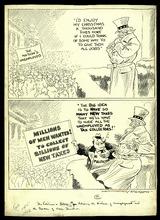
Description: Editorial cartoon depicting Uncle Sam trying to think of a way to give the unemployed jobs. Politician suggests to Uncle Sam that unemployed collect new taxes.
Member of: McCutcheon Editorial Cartoons - ALL (Collection)
Resource Type: Still Image
JM-321: The ideal ally
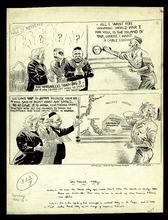
Description: Editorial cartoon set after WWI. While the spoils are broken up, Uncle Sam wishes for one island, but the spokesperson stepped out. Now Japan holds most strategic islands.
Member of: McCutcheon Editorial Cartoons - ALL (Collection)
Resource Type: Still Image
JM-017: Three scenes pertaining to a political convention

Description: Editorial cartoon depicting three different scenes revolving around a political convention. In the first panel, men cheer and remark how they have been cheering for thirty-five minutes for someone and are trying to reach forty. In the middle panel, a man receives his bill at a restaurant and says that he will have to either go home or go hungry when he next goes to a political roll call. In the third panel, a KKK member appears to a platform maker while he is in bed warning about mentioning the group.
Member of: McCutcheon Editorial Cartoons - ALL (Collection)
Resource Type: Still Image
JM-W007: They all belong to the same union
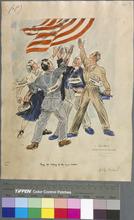
Description: Editorial cartoon depicting figures labeled "Women", "Labor", "Capital", and "Fighting Men" all reaching towards an American Flag above them.
Member of: McCutcheon Editorial Cartoons - ALL (Collection)
Resource Type: Still Image
JM-205: Contention in Progressive Party candidates in 1912 and 1924

Description: Editorial cartoon depicting two panels set at different presidential elections. In the top panel, Robert La Follette sulks inside while Theodore Roosevelt marches outside in a 1912 Progressive Party parade. In the bottom panel, the spirit of Theodore Roosevelt accuses La Follette of having no right to carry the Progressive Party banner in a later parade, also with representatives from the Socialist Party and the Farmer-Labor Party. In 1912, La Follette was hoping to be the presidential nomination for the progressive wing of the Republicans, but his supporters abandoned him in favor of Theodore Roosevelt when the former president announced his return to politics, and Roosevelt became the 1912 presidential candidate for the Progressive Party instead; La Follette supported Wilson in the election. When the Progressive Party re-formed, after World War 1, they chose La Follette as their presidential candidate at a convention in Ohio in July of 1924; the Socialist Party and Farmer-Labor Party joined La Follette's progressive platform.
Member of: McCutcheon Editorial Cartoons - ALL (Collection)
Resource Type: Still Image
JM-210: Some angles of the threatened railway strike
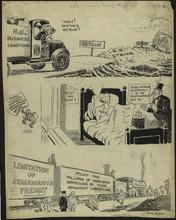
Description: Editorial cartoon split in to three panels, each one showing a possible consequence of the impending railroad strike. In the top panel, Uncle Same driving a truck labeled "U.S. Business Conditions" and a truck labeled "Winter" stopped on the road by detour signs with the railroad strike causing the disruption and need for a detour. In the middle panel, a man representing the United States is in bed sick and resting while the doctor tells him he should be fine as long as no complications set in; running towards the house is a boy with a newspaper proclaiming the railroad strike. In the bottom panel, striking railroad workers stand around a train which is carrying relief for workers suffering from armament competitions.
Member of: McCutcheon Editorial Cartoons - ALL (Collection)
Resource Type: Still Image
JM-228: All aboard the grand experiment
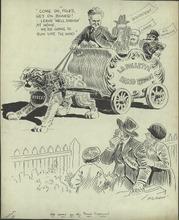
Description: Editorial cartoon depicting Robert M. La Follette Sr. trying to get people to hop on his bandwagon along with Discontent, Labor, and New York Socialists.
Member of: McCutcheon Editorial Cartoons - ALL (Collection)
Resource Type: Still Image
JM-290: Death's new favorite
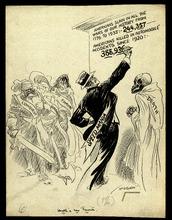
Description: Editorial cartoon depicting "Speed Mania" totals up more deaths than wars.
Member of: McCutcheon Editorial Cartoons - ALL (Collection)
Resource Type: Still Image
JM-038: Hindered progress when horses are different houses
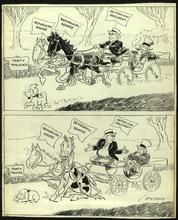
Description: Editorial cartoon depicting the president and Uncle Sam appearing happy when both horses pulling their carriage along are Republican, signifying a Republican Senate and House. When the Senate is a Democrat horse, the carriage is at a standstill and both the president and Uncle Sam both have annoyed, unhappy expressions on their faces.
Member of: McCutcheon Editorial Cartoons - ALL (Collection)
Resource Type: Still Image
JM-231: A New Sign at the White House
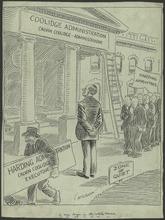
Description: Editorial cartoon depicting Calvin Coolidge cleaning house in the aftermath of the Harding administration.
Member of: McCutcheon Editorial Cartoons - ALL (Collection)
Resource Type: Still Image
JM-043: Wilson expanding the Monroe Doctrine while Uncle Sam worries about America
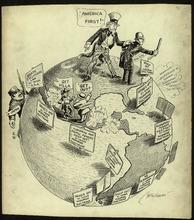
Description: Editorial cartoon depicting President Wilson standing on a globe and acting as a policeman of the world. Uncle Sam grabs his arm and says, "America first!" All over the globe, signs depict new orders and laws based on Wilson's expansion of the Monroe Doctrine. Wilson is credited with expanding the Doctrine to allow for "Missionary Diplomacy" in locations such as Mexico, Central America, and the Caribbean.
Member of: McCutcheon Editorial Cartoons - ALL (Collection)
Resource Type: Still Image
JM-296: Problem of conduct
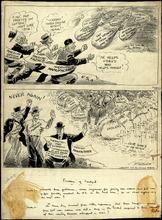
Description: Editorial cartoon depicting three American businessmen profiting from WWI. In the next panel, they turn away from promise of wealth and say "Never again" since the costs to nation not worth it.
Member of: McCutcheon Editorial Cartoons - ALL (Collection)
Resource Type: Still Image
JM-242: Chairman Butler reports to his chief
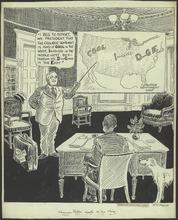
Description: Editorial cartoon depicting William M. Butler reporting to Calvin Coolidge.
Member of: McCutcheon Editorial Cartoons - ALL (Collection)
Resource Type: Still Image
JM-012: Some idle thoughts on the law
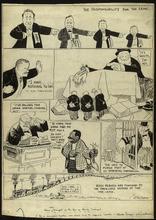
Description: Editorial cartoon depicting six unrelated panels. In the top one, a judge and his staff each point at the person smaller than they are as the person responsible for the leak. In the next panel, Theodore Roosevelt is shown saying he has nothing to say that is fit for publication. In the panel next to him, a large man points to his hand, titled "subsidiary committee" as to the place the blame should go to. In the next panel, a man is being charged $5 under "Anglo-Saxon Law for Chicken Embezzlement". the next panel shows a man, representing a corporation, sitting in a jail cell with his hand hanging outside the bars so only part of the corporation is being punished. The last, bottom panel shows a man on a cart pulled by a donkey waiting for a large train to travel past him.
Member of: McCutcheon Editorial Cartoons - ALL (Collection)
Resource Type: Still Image
JM-094: At the office of the Harriman Rex Railroads
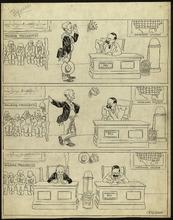
Description: Editorial cartoon depicting three panels showing the office of the Harriman Rex Railroads. In the first panel, a newcomer enters the office and speaks to Harriman. In the next panel, Harriman and the other men in the office throw up their hands and smile at the new man, who is established in the office with his own desk in the last panel. E.H. Harriman was known for his prowess as a railroad executive and especially for being the "savior" of failing railroads, including the transcontinental Union Pacific Railroad.
Member of: McCutcheon Editorial Cartoons - ALL (Collection)
Resource Type: Still Image
JM-304: Different depictions of Dewey
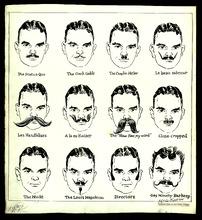
Description: 12 portraits of Dewey with different hair and mustache styles.
Member of: McCutcheon Editorial Cartoons - ALL (Collection)
Resource Type: Still Image
JM-233: One of the mysteries of golf
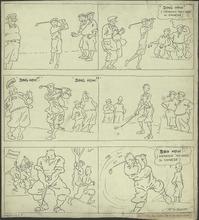
Description: Editorial cartoon depicting golfers being judged by onlookers in Chinese.
Member of: McCutcheon Editorial Cartoons - ALL (Collection)
Resource Type: Still Image
JM-203: Big Bills
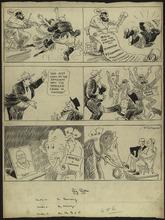
Description: Editorial cartoon depicting three scenes showing the reparations against Germany preventing the country from holding civilization again, the crime wave hitting Chicago even when one man believes he has ended it, and the G.O.P. elephant looking for a candidate but finding Taft being friendly with Wilson.
Member of: McCutcheon Editorial Cartoons - ALL (Collection)
Resource Type: Still Image
JM-317: Those purge tactics are hearing an awful political kick-back
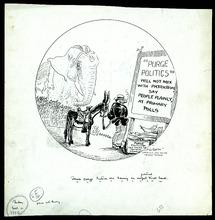
Description: Editorial cartoon depicting a man reading primary results: purge politics not patriotic.
Member of: McCutcheon Editorial Cartoons - ALL (Collection)
Resource Type: Still Image
JM-C010: The changing world: Books that caused fear now and then
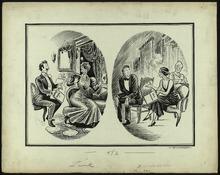
Description: Editorial cartoon consisting of two scenes. In the first scene, a Victorian woman is recoils from a "Ouida" book presented to her by a man. In the second scene, a woman in 1920s attire shows a sweating man a book titled "Sex Problem". "Ouida" was the pseudonym of the English novelist Maria Louise Ramé, who was known for her literary salon and the scandalous books she published toward the beginning of her career.
Member of: McCutcheon Editorial Cartoons - ALL (Collection)
Resource Type: Still Image
JM-200: Our foreign relations after the war
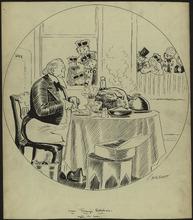
Description: Editorial cartoon depicting Uncle Sam eating a large meal while kings wearing tattered robes look in through a window.
Member of: McCutcheon Editorial Cartoons - ALL (Collection)
Resource Type: Still Image
JM-085: The war department - "Great scott, that dispatch must mean ladrones instead of insurgents. There are no insurgents out there."
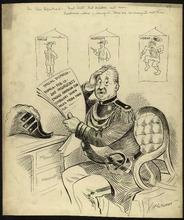
Description: Editorial cartoon depicting a military man confused by the wording of a special dispatch about fighting in Manila. Three pictures hang on the wall behind him distinguishing the perceived differences between an "Amigo," an "Insurgent," and a "Ladrone." The special dispatch claimed that the fighting was started by "Insurgents" instead of the "Ladrones" classification the man remarks that the report must have meant.
Member of: McCutcheon Editorial Cartoons - ALL (Collection)
Resource Type: Still Image
JM-028: "Call Judge Landis!"
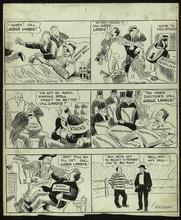
Description: Editorial cartoon depicting six scenes of people in difficult situations calling for Judge Landis. In the first panel, Organized Baseball is lying in a hospital bed and onlookers call outside the frame for someone to send for Judge Landis. In the second panel, locksmiths having difficulty with a Building Deadlock call for Judge Landis. In the third panel, a figure labeled "Stocks" tells Wall Street that he isn't feeling well and asks for Judge Landis. In the fourth panel, the 18th Amendment claims to have too many doctors and calls for Judge Landis. In the fifth panel, the Grain Exchanges flinch away from the painful dentistry of Farmers and ask for Judge Landis. In the last panel, two men are gearing up for a fight and wonder if they should call Judge Landis. Landis is the same judge referred to in JM-213: https://dl.mospace.umsystem.edu/mu/islandora/object/mu%3A419248 .
Member of: McCutcheon Editorial Cartoons - ALL (Collection)
Resource Type: Still Image
JM-287: Uncle Sam will soon be alone with his recovery diet and digestion
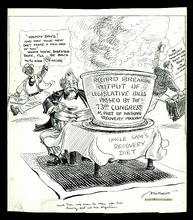
Description: Editorial cartoon depicting Uncle Sam bloated by huge output of legislation by 73rd Congress.
Member of: McCutcheon Editorial Cartoons - ALL (Collection)
Resource Type: Still Image
JM-274: Guiding hands
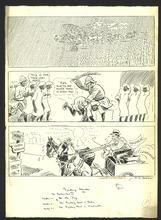
Description: Radio guides plane; British officer beats Indian; Hoover calls extra session.
Member of: McCutcheon Editorial Cartoons - ALL (Collection)
Resource Type: Still Image
JM-W002: New York expects you to do your duty
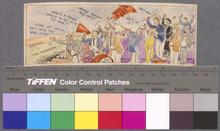
Description: Editorial cartoon depicting a group of men and women standing at the banks of the Hudson river with a war drum and banner. They are calling across the river at Westerners to urge them to join in the war.
Member of: McCutcheon Editorial Cartoons - ALL (Collection)
Resource Type: Still Image
Pagination
- Page 1
- Next page